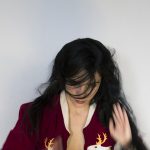The rhythmic flow and poetic abstraction of “5 AM” (“5 Heures du Matin”) lends the whole of Paula de Vasconcelos’ well-produced and visually outstanding dance/theatre work a polished choreographic feel. Yet the pure dance sections themselves were disappointing. In fact, it’s hard to believe the same person who developed the subtle relationship between the existentially troubled main character and her warm and patient psychiatrist also choreographed the tedious gymnastic displays.
Directed, choreographed, designed and costumed by de Vasconcelos, co-artistic director of Montréal-based Pigeons International, “5 AM” is impressive for its fluid staging, shifting easily between a range of dance, theatre and, unusually, a slide show. The latter is key to the staging, as the main set piece is an enormous white screen that fills the back wall of the performing space, onto which eighty-five black and white photographs by Québécois photographer Serge Clément are projected. These stunning images of people, landscapes and cities are from a commissioned series of photos taken at dawn in Dakar, Senegal; Lisbon, Portugal; Budapest, Hungary; Istanbul, Turkey; Mumbai, India; Bangkok, Thailand; Val Paraiso, Chile; and New York, the only North American city.
Well-used throughout are two chairs facing each other on opposite sides of a raised parquet floor. Their main occupants are an insomniac forty-one-year-old photographer (played by Violette Chauveau) who can only fall asleep when dawn comes, and her psychiatrist (played by Bruno Schiappa). Both actors give strong, understated performances. Chauveau’s character is deeply troubled with concern over the state of humanity, and Schiappa, as the therapist, listens, encourages and – more surprisingly – dispenses spiritual succour. His sense of hope quietly informs the show, making “5 AM” an ultimately uplifting meditation on existence.
But then there is the element of choreography, created by primarily theatre-trained de Vasconcelos who, since 1997, has apparently been drawn to a dance/theatre mix. Structurally, the work moves elegantly between the therapy sessions and the dance. The latter includes pure dance performed in front of the projected photos and character-driven solos by Paul-Antoine Taillefer (Pigeons International’s other co-artistic director). Unfortunately, only a few sections of dance have any choreographic or dramatic interest.
The pure dance is often romantically inclined, performed by Milene Azze and Taillefer. Taillefer seems there mostly to facilitate Azze, as in the duet when he lies asleep on the floor, a foil for Azze’s split-leg stretches. At other times, Azze and Nathalie Blanchet (who opened the piece strongly and enticingly in a black slip) hurl themselves into curvy balance-beam style arabesques that are a signature of the choreography. Towards the end, Azze has the unhappy distinction of being continually hoisted aloft at the waist by Taillefer in order to indulge in numerous twinkling entrechats. Besides this rudimentary use of ballet and gymnastics, there is a jazz influence in the freedom with which both women thrust their hips out and in the general punchy-ness of much of their movement.
A statement that comes from the photographer when she doesn’t know what to say to her psychiatrist seems to sum up what the dance is intended to portray. The best moments in our lives, she explains, are not lived through words: “We live them through our bodies.” Interestingly, however, the best moments in “5 AM” portray more conflicted moments. One is when Taillefer does a quickly moving duet with a chair, full of shifting weight changes as he leans against, stands on and generally drapes himself around it. His inner turmoil is expressed through the unease of his constantly shifting dance, contrasting with the way the photographer expresses her distress by sitting unnaturally still.
The evening’s most delightful section has Taillefer back on the chair, this time with the psychiatrist sitting opposite. At this late stage of the work, Taillefer’s dance is informed by the photographer’s earlier explanation about how difficult it is to find the right words to say, and how limiting words are. It was too bad, the psychiatrist had replied, that he couldn’t read her mind. Now, notebook in hand, he seems perfectly comfortable reading the dance. He even responds physically at times, quietly and succinctly flinging his arm lightly back over his head. Here, the dance makes marvelous narrative sense, with rhythm and subtext, which is something the pure dance lacks.
Accompanying the dance, and sometimes just the photographs, is a musical score by a mix of composers. This includes excerpts from an album called “Selwa” by guitarist Steve Tibbetts and a Buddhist nun from Tibet, Chöying Drölma, as well as from Oleksa Lozowchuk’s “Bright Sadness”, a chamber work featuring the cello. The spoken word, which also comes from more than one source, is primarily dialogue between Chauveau and Schiappa, or excerpts from the work of Portuguese poet Fernando Pessoa. At the end, Chauveau faces the audience directly to recite from Pessoa’s “Time’s Passage”; “… and the sun rises every morning” are her last, optimistic, words.
“5 AM”, which premiered in Montréal in 2005, is the second show of a trilogy that centres on the state of the world. The first, “Babylon”, premiered in 2004. I will definitely keep an eye out for part three, but if it’s as multidisciplinary as the present one, I will also keep my fingers crossed that de Vasconcelos will develop the dance until it is as nuanced as every other part.
By Kaija Pepper
Tagged: Dance Theatre, Performance, BC





